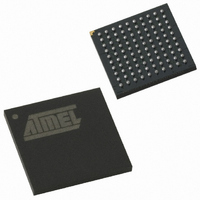AT89C51SND2C-7FTUL Atmel, AT89C51SND2C-7FTUL Datasheet - Page 61

AT89C51SND2C-7FTUL
Manufacturer Part Number
AT89C51SND2C-7FTUL
Description
IC 8051 MCU FLASH 64K MP3 100BGA
Manufacturer
Atmel
Series
89Cr
Datasheet
1.AT89C51SND2C-7FTUL.pdf
(242 pages)
Specifications of AT89C51SND2C-7FTUL
Core Processor
8051
Core Size
8-Bit
Speed
40MHz
Connectivity
I²C, IDE/ATAPI, MMC, SPI, UART/USART, USB
Peripherals
Audio, I²S, MP3, PCM, POR, WDT
Number Of I /o
32
Program Memory Size
64KB (64K x 8)
Program Memory Type
FLASH
Ram Size
2.25K x 8
Voltage - Supply (vcc/vdd)
2.7 V ~ 3.3 V
Data Converters
A/D 2x10b; D/A 2x20b
Oscillator Type
Internal
Operating Temperature
-40°C ~ 85°C
Package / Case
100-TFBGA
Data Bus Width
8 bit
Data Ram Size
2.25 KB
Interface Type
ATAPI, I2S, IDE, SPI, UART, USB
Maximum Clock Frequency
40 MHz
Number Of Programmable I/os
32
Number Of Timers
2
Maximum Operating Temperature
+ 85 C
Mounting Style
SMD/SMT
Minimum Operating Temperature
- 40 C
Lead Free Status / RoHS Status
Lead free / RoHS Compliant
Eeprom Size
-
Lead Free Status / Rohs Status
Details
Other names
AT89C51SND2C7FTUL
Available stocks
Company
Part Number
Manufacturer
Quantity
Price
Company:
Part Number:
AT89C51SND2C-7FTUL
Manufacturer:
ATMEL
Quantity:
4 371
- Current page: 61 of 242
- Download datasheet (3Mb)
12.3
12.3.1
4341H–MP3–10/07
Watchdog Operation
WDT Behavior during Idle and Power-down Modes
After reset, the WDT is disabled. The WDT is enabled by writing the sequence 1Eh and E1h into
the WDTRST register. As soon as it is enabled, there is no way except the chip reset to disable
it. If it is not cleared using the previous sequence, the WDT overflows and forces a chip reset.
This overflow generates a high level 96 oscillator periods pulse on the RST pin to globally reset
the application (refer to Section “Power Management”, page 47).
The WDT time-out period can be adjusted using WTO2:0 bits located in the WDTPRG register
accordingly to the formula shown in Figure 12-3. In this formula, WTOval represents the decimal
value of WTO2:0 bits. Table 12-1 reports the time-out period depending on the WDT frequency.
Figure 12-3. WDT Time-Out Formula
Table 12-1.
Notes:
Operation of the WDT during power reduction modes deserves special attention.
The WDT continues to count while the AT8xC51SND2C is in Idle mode. This means that you
must dedicate some internal or external hardware to service the WDT during Idle mode. One
approach is to use a peripheral Timer to generate an interrupt request when the Timer over-
flows. The interrupt service routine then clears the WDT, reloads the peripheral Timer for the
next service period and puts the AT8xC51SND2C back into Idle mode.
The Power-down mode stops all phase clocks. This causes the WDT to stop counting and to
hold its count. The WDT resumes counting from where it left off if the Power-down mode is ter-
minated by INT0, INT1 or keyboard interrupt. To ensure that the WDT does not overflow shortly
after exiting the Power-down mode, it is recommended to clear the WDT just before entering
Power-down mode.
The WDT is cleared and disabled if the Power-down mode is terminated by a reset.
WTO2
0
0
0
0
1
1
1
1
1. These frequencies are achieved in X1 mode or in X2 mode when WTX2 = 1:
2. These frequencies are achieved in X2 mode when WTX2 = 0: F
WTO1
0
0
1
1
0
0
1
1
F
WDT
WDT Time-Out Computation
= F
WTO0
0
1
0
1
0
1
0
1
OSC
÷ 2.
6 MHz
131.07
262.14
524.29
16.38
32.77
65.54
1049
2097
WDT
(1)
TO
=
6
8 MHz
196.56
786.24
12.28
24.57
49.14
98.28
393.1
⋅ ((
1572
2
14
(1)
⋅
F
2
WDT
WTOval
10 MHz
157.29
314.57
629.15
) – 1)
19.66
39.32
78.64
1258
9.83
AT8xC51SND2C/MP3B
F
(1)
WDT
(ms)
12 MHz
131.07
262.14
524.29
16.38
32.77
65.54
1049
8.19
(2)
WDT
= F
16 MHz
196.56
393.12
786.24
12.28
24.57
49.14
98.28
OSC
6.14
.
(2)
20 MHz
157.29
314.57
629.15
19.66
39.32
78.64
4.92
9.83
(2)
61
Related parts for AT89C51SND2C-7FTUL
Image
Part Number
Description
Manufacturer
Datasheet
Request
R

Part Number:
Description:
DEV KIT FOR AVR/AVR32
Manufacturer:
Atmel
Datasheet:

Part Number:
Description:
INTERVAL AND WIPE/WASH WIPER CONTROL IC WITH DELAY
Manufacturer:
ATMEL Corporation
Datasheet:

Part Number:
Description:
Low-Voltage Voice-Switched IC for Hands-Free Operation
Manufacturer:
ATMEL Corporation
Datasheet:

Part Number:
Description:
MONOLITHIC INTEGRATED FEATUREPHONE CIRCUIT
Manufacturer:
ATMEL Corporation
Datasheet:

Part Number:
Description:
AM-FM Receiver IC U4255BM-M
Manufacturer:
ATMEL Corporation
Datasheet:

Part Number:
Description:
Monolithic Integrated Feature Phone Circuit
Manufacturer:
ATMEL Corporation
Datasheet:

Part Number:
Description:
Multistandard Video-IF and Quasi Parallel Sound Processing
Manufacturer:
ATMEL Corporation
Datasheet:

Part Number:
Description:
High-performance EE PLD
Manufacturer:
ATMEL Corporation
Datasheet:

Part Number:
Description:
8-bit Flash Microcontroller
Manufacturer:
ATMEL Corporation
Datasheet:

Part Number:
Description:
2-Wire Serial EEPROM
Manufacturer:
ATMEL Corporation
Datasheet:











